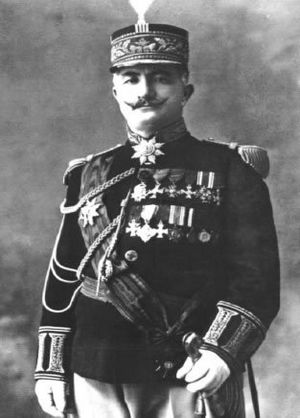Agha Petros facts for kids
Quick facts for kids
Petros Elia of Baz
ܦܸܛܪܘܿܣ ܐܹܠܝ݂ܵܐ ܕܒܵܙ |
|
|---|---|
 |
|
| Birth name | Petros Elia |
| Nickname(s) | Agha Petros |
| Born | April 1880 Baz, Hakkari, Ottoman Empire |
| Died | 2 February 1932 (age 51) Toulouse, France |
| Allegiance | Allies of World War I, Assyrian volunteers during World War I |
| Years of service | 1914–1919 |
| Commands held | Assyrian volunteers, later the Assyrian Levies |
| Battles/wars | World War I
|
| Awards | Croix de Guerre (France) Ordre national de la Légion d'honneur (France) |
Petros Elia of Baz (also known as Agha Petros) was an important Assyrian military leader. He lived from April 1880 to February 1932. He played a big role during World War I.
Early Life and Education
Petros Elia was born in 1880 in the village of Lower Baz. This area was part of the Ottoman Empire at that time. He started his education in his village. Later, he went to a European missionary school in Urmia, a city in Persia.
After finishing school, he returned to Baz and became a teacher. Petros was very good at languages. He could speak Syriac, Turkish, Arabic, French, Persian, Kurdish, English, and Russian. Because of his language skills, the Ottoman government hired him. In 1909, he worked briefly as a secretary and a Consul in Urmia.
Agha Petros in World War I
When Russian forces entered Urmia, Agha Petros was made a general. He led a small group of Assyrian volunteers. He fought and won several battles against the Ottoman and Kurdish forces. Later, the Allies (countries fighting against the Central Powers in World War I) asked him to join them. He was given command of the left side of the Assyrian volunteers' army. The right side was led by Dawid Mar Shimun, brother of Mar Shimun. Mar Shimun himself commanded the center.
Agha Petros and his volunteers had many successes against the Ottoman army. One important victory was at Suldouze. There, Petros's 1,500 horsemen defeated Kheiri Bey's force of 8,000 men. Petros also won a major battle at Sauj Bulak. He pushed the Ottoman forces back to Rowanduz.
Agha Petros sometimes had limited control over other groups, including some Armenians and other Assyrian forces. He was not always trusted by everyone. There were some disagreements within the ranks. Instead of keeping his forces to contain the Turks, he moved them to Sain Kala. He did this because British officials promised him military help there. However, the British did not keep their promise. He arrived at Sain Kala seven days after the British troops had left.
After the Young Turks invaded Mosul, General Agha Petros led the Assyrian army. They fought hard and successfully against the Ottoman army and their Kurdish allies. They pushed them out of Mosul and the surrounding area. This led to Britain taking control of the region. Details of these battles are found in letters from Petros and British officials.
Agha Petros had some disagreements with Mar Shimun, who was the patriarch (religious leader) of the Assyrian Church of the East. Mar Shimun's family often did not trust Petros. Allied military advisors reported that Petros tried to turn the Allies against the Patriarch. However, after Mar Shimun was killed by the Iranian Kurdish leader Simko, Agha Petros joined forces with Malik Khoshaba and others. Together, they drove Simko from his stronghold at Koynashahr.
After the War
Petros was the main negotiator for the Assyrians between 1919 and 1923. On July 24, 1923, he attended the League of Nations Peace Conference in Lausanne, Switzerland. There, he talked with the Turkish delegation. He proposed that Assyrians could resettle in and around Hakkâri Province. In return, the Assyrians would be loyal to Turkey. The Turkish foreign minister, İsmet İnönü, was open to this idea. But a message from the government in Ankara stopped the plan.
In his final years, Petros moved near Toulouse, France. He lived there until his death on February 2, 1932. He died from a cerebral attack at the railway station.
See also

